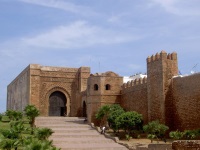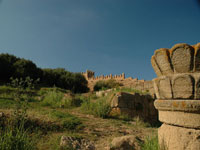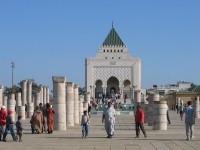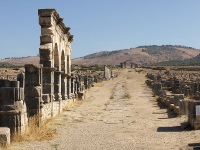Things to do in Rabat
Rabat's Medina, or old city, was created by Andalusian Muslim refugees from Badajoz in Spain, and was essentially all there was to the city until the arrival of the French in 1912 and the subsequent building of the Ville Nouvelle or new quarter. The Medina is small and not as interesting or attractive as the old city sections of Fez or Marrakech, but the foundouks (traditional cafes) and shops make for a lively atmosphere.
Souika Street is the main artery through the Medina, where visitors will find the leather sellers at the Sebbat souk (footwear bazaar). In Consules Street, shops sell curiosities, souvenirs, and Moroccan craft items such as copper and embroidery as well as the famed Rabat carpets. Another wonderful area to explore in Rabat is the Kasbah des Oudaias, with its famous white and blue buildings and lovely views.
Rabat is blessed with some captivating ancient ruins that will delight history buffs. The Citadel of Chellah was once a Roman port city and the remains of this centre are interspersed with the tombs of an Almohad necropolis. Another must-see is Volubilis, situated between Rabat and Fez, which was once a Roman city, and still holds some amazing ruins and mosaics.
There are also numerous popular excursions from the city, including the seaside town of Temara. It's a convenient eight miles away (13km) from Rabat, and is a favourite weekend picnic spot and campsite for city dwellers. The town has several pleasant stretches of sand, and some good hotels, restaurants, and nightclubs. The ancient city of Meknes is also within reach.

Kasbah des Oudaias
The Kasbah des Oudaias was added to UNESCO's list of World Heritage Sites in 2012, and is a pleasant place to take a stroll and admire some interesting architecture. The Kasbah was…
Kasbah des Oudaias
The Kasbah des Oudaias was added to UNESCO's list of World Heritage Sites in 2012, and is a pleasant place to take a stroll and admire some interesting architecture. The Kasbah was the Alhomad citadel of medieval Rabat, and is guarded by an impressive arched gate built around 1195. Inside the Kasbah is the palace and Andalusian gardens, as well as a broad terrace, which gives beautiful views of the river and sea close to the city's oldest mosque, the Kasbah Mosque, built in 1050. Below the terrace are several fortifications with gun emplacements guarding the estuary, and even further below lies a beach that is usually crowded with locals.

The Citadel of Chellah
Emerging from the boulevards of the Ville Nouvelle (New Town) of Rabat, travellers will come across the ruins of Chellah. Once the thriving walled Roman port city of Sala Colonia, …
The Citadel of Chellah
Emerging from the boulevards of the Ville Nouvelle (New Town) of Rabat, travellers will come across the ruins of Chellah. Once the thriving walled Roman port city of Sala Colonia, it was abandoned in 1154 in favour of Sale across the river mouth. In the time of the Almohads the site was used as a royal burial ground and, following this, the Merenid sultan, Abou El Hassan, added some monuments and the striking main gate in the mid-14th century. Just inside the gate are Roman ruins dating from 200 BC, which include a forum, a temple and a craftsmen's quarter. The citadel is now part of a garden, and in spring the ruins are surrounded by a beautiful variety of flowers.

Hassan Tower
The massive Hassan Tower, which dates to 1196, is the minaret of a mosque and towers over the capital, Rabat. However, the huge Rabat Mosque itself was never completed and was larg…
Hassan Tower
The massive Hassan Tower, which dates to 1196, is the minaret of a mosque and towers over the capital, Rabat. However, the huge Rabat Mosque itself was never completed and was largely destroyed in an earthquake in 1755. The mosque and the minaret were intended by the builders to be the largest in the world but today all that is left of the mosque are several walls in various states of ruin and 200 columns. Also, the minaret, made from striking red sandstone, is unusually situated at the centre of the mosque building, and was intended to be 262ft (80m) high, though it stands at 164ft (50m). Each façade of the minaret is intricately patterned with different motifs on each face.

Volubilis
Volubilis lies near the Moroccan town of Meknes and is situated between Rabat and Fez. Historically it was a central Roman administrative city in Africa from around the third centu…
Volubilis
Volubilis lies near the Moroccan town of Meknes and is situated between Rabat and Fez. Historically it was a central Roman administrative city in Africa from around the third century BC, and was built atop a previous Carthaginian city. Volubilis was unique in that it was not abandoned after the Romans lost North Africa to the Arabs, with even the Latin language living on in the area for several centuries. Volubilis remained inhabited until the 18th century, when it was demolished to provide building materials for the palaces of Moulay Ismail in nearby Meknes, which meant that a great deal of the Roman architectural heritage was lost. Today the ruins are a UNESCO World Heritage Site and consist of some well-preserved columns, a basilica, a triumphal arch and about 30 magnificent mosaics.



